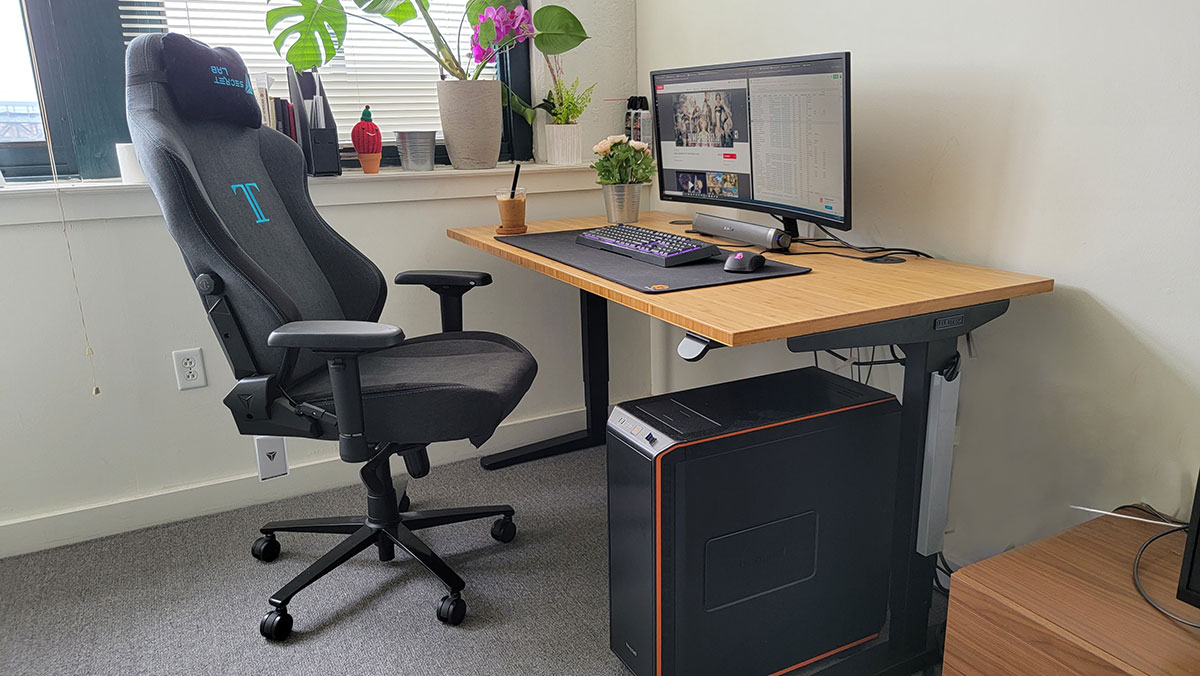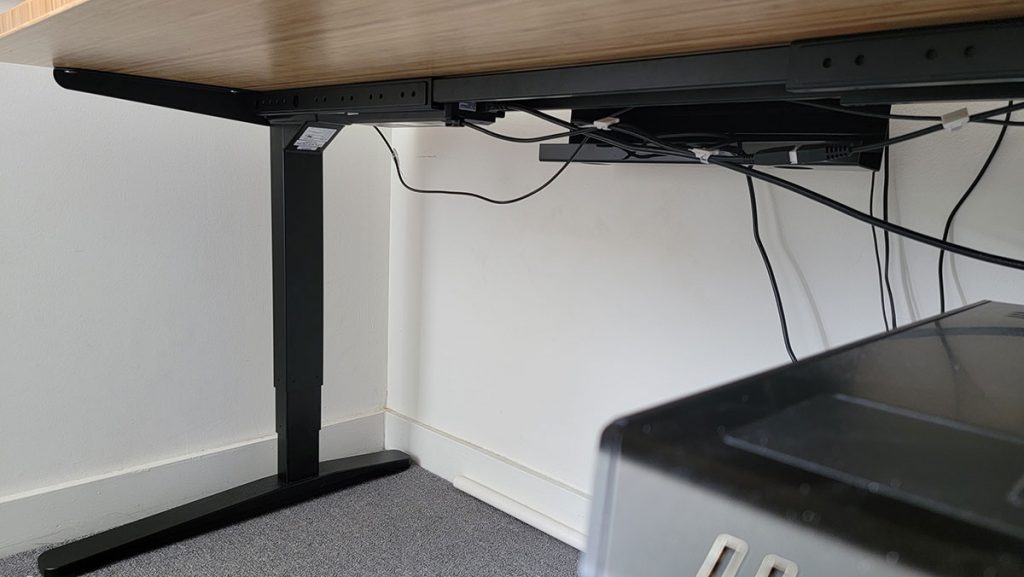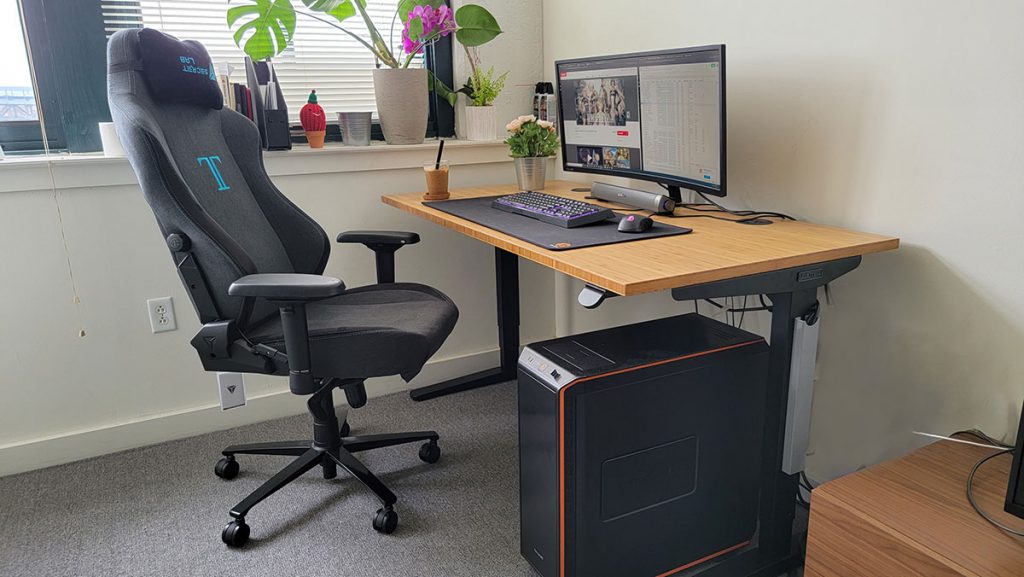Business
Is The Uplift Desk V2 Worth It? (Review)
Published
4 years agoon

Standing desks are all the rage nowadays ever since we’re all forced to work from home. Sitting at a desk all day for both work and pleasure can be unhealthy. Having a motorized standing desk is gives your productivity a new level of verticality you didn’t know you needed. If you’re on the market for a new standing desk, chances are you’ve run into Uplift. They’re one of the more premium standing desk manufacturers that’s known for quality and customizability. If you’re curious if they’re the right fit for your work style, read on to find out.
Our Standing Desk Spec
- 60 x 30 +$110
- Bamboo +$40
- V2 C frame
- One power Grommet Cover +$39
- Advanced Paddle Keypad +$59
- Total: $816
Add-on
- Magnetic cable channel +$19 (for cable management)
Coming in multiple pieces
One thing to note is that your packages will come in multiple pieces and may not all arrive simultaneously. This is important for city dwellers who live in tight apartments and have to schedule their deliveries to be picked up at a local UPS or USPS store.

Also, when ordering, pay close attention to the availability of the different types of tabletops. Some of the more exclusive wood will have significantly longer preparation time. In our case, the 60″x30″ bamboo tabletop could ship out the next day and didn’t have to wait long.
Assembly

If you’re worried that assembly will be complicated, fear not – it’s not. The Uplift team did a great job with their simplified instruction manual and neat packaging. All the nuts, bolts, and washers are clearly labeled. I recommend having a bowl or tray to keep everything organized during assembly.
When assembling the legs into the center frame piece, make sure you have the middle frame RIGHT side up. The manual didn’t indicate which side is up/down, but the pictures are accurate. So be sure to follow the diagram and make sure that the center frame is orientated correctly. I had to redo the leg assembly because I was careless.
Complete assembly of the standing desk took about 1 hour with just one person. You can easily do this alone, and honestly, I don’t think having a partner helping will expedite the process much. You definitely will need someone’s help to flip the desk over once the assembly is complete.
Quality Craftsmanship

Every single piece we held up had a sizable heft to them. We spent a lot of time admiring the craftsmanship of the desk during assembly. Although there aren’t that many pieces to put together, each one was thoughtfully engineered. Making the assembly process simple, painless, and intuitive is an art that’s often under-appreciated.
Cable Management

I’m glad Uplift provided a cable management kit. My advice would be to do all of your cable management BEFORE flipping the desk over. Once you flip it over, it’s going to be a painful process. My one complaint is that the double-sided tape is too weak to hold up the thicker cables. The smaller wires held up just fine, but the thick power cables proved to be too heavy.
Responsiveness

The paddle controller is well worth the extra $59. Adjusting the desk’s height was as simple as lightly tapping up or down on the paddle. There’s a 1-second delay between the click and the desk lifting, which is excellent. That 1-second of lag input between hearing the click and the desk moving gave me more precise control. I’ve reviewed other desks that were either too delayed or too responsive, making the exact height adjustment nearly impossible. The motor doesn’t move too quickly or too slow—just the perfect speed to gauge precisely when to stop.
Stability
The desk is stable regardless of the height setting. That should come as no surprise given the weight of the desk. Most standing desks are sturdy below 35″. However, the desk loses that rigidity when fully extended. I didn’t experience that issue with the Uplift desk. Even fully extended, the desk remained stable and wobble-free, making it suitable for most of my work and gaming needs.
Noise Level
It certainly is noticeable when the motors are moving, but nothing major. Overall, it’s reasonably quiet and shouldn’t be a significant concern. The motor humming is unlikely to wake up a baby or annoy your neighbor.
Aesthetic

Now let’s get to the real reason why you’re picking this up over a cheap Ikea or Amazon Basic standing desk. It looks expensive and gorgeous in any room. Uplift didn’t skimp on where it matters the most – the tabletop. You’ll notice right away is how thick and generous the tabletop is. I got the 60″ bamboo finish with a black base, and it looks even better in person. Almost everyone who’s stepped foot into my home office has asked about the desk.
The aesthetic appeal of a 60″ bamboo finish standing desk was an unexpected and welcomed surprise. I knew that it would look professional for the price; I didn’t think it would be a centerpiece.
Extremely Well Built
Depending on the tabletop, options, and accessories you select, your Uplift desk could easily be $1000+. What may seem costly at first will eventually feel like an excellent investment. After I started using the Uplift desk daily, I noticed just how much I enjoy being at my desk. Switching from sitting to standing was a breeze with the paddle switch. It takes less than seconds for me to adjust the desk to my desired height fully.
A good working environment can significantly affect our productivity. And the best tool we can invest in is a quality desk – particularly a standing desk. One of the best things about the Uplift desk that makes it such a joy to use is that it’s well built. I’ve mentioned the craftsmanship at least three times in this review because that’s the thing you’ll likely notice and appreciate the most.
Final Verdict
Uplift makes one of the most premium standing desks on the market today. The prices aren’t cheap; however, they’re well worth the investment. Our 60″ bamboo finish with all the added accessories came out to just over $800. It certainly is an investment. If you’re looking for a desk that can accommodate both your work/life productivity needs, the Uplift desk is well worth the investment.
You may like
10 Social Media Marketing Tools to Check Out in 2025
The 10 Best Small Business Budgeting Software for 2025
Failure to Launch: Why Pixar’s Lightyear is a Box Office Dud
BeReal App: Will It Ever Survive Its Instagram Clone?
Lesbian Bars Were Dying. Now They’re Making a Comeback
Wally Amos: From Cookie Mogul to Life’s Tough Lessons
Business
Failure to Launch: Why Pixar’s Lightyear is a Box Office Dud
Published
4 days agoon
June 12, 2025
This summer’s movie season is now in full swing, and turnout is strong. Franchise films are facing a decline in dominance, but still hold a significant portion of the box office. In addition, original hits have proven that fresh storytelling can still break through.
Of course, challenges are there. With streaming habits, changing audience expectations, and the unpredictability of box office trends, studios are being kept on their toes. But one thing has remained constant: Pixar’s tentpole releases reliably soar past the billion-dollar mark.
Or so we thought.
Just before the pandemic, Pixar crossed a billion with Toy Story 4, one year after crushing it with Incredibles 2. Now, after a string of Disney+ releases, they’ve taken another big swing with the Toy Story spinoff Lightyear.
Then, bullish projections had Lightyear nearing a nine-figure opening weekend and cruising to $500m from there. Instead, the family-friendly tentpole opened second, failing to surpass a plummeting Jurassic World Dominion.
Why did Lightyear flop?
You probably seen the headline: Lightyear bombs. Disappointing on its face, but the ramifications go far beyond the potential for a Woody’s Roundup spinoff film.
The past couple Pixar films (Soul, Luca, Turning Red) released exclusively on Disney+. Many maligned the shafting of these exciting animated films. It’s especially upsetting for Turning Red, which could’ve easily been one of 2022’s runaway box office hits.
Lightyear is the test. A new direction for Pixar’s biggest franchise. The most means-tested Pixar film gets the theatrical boost, and if it does well, the other movies follow. For this reason, it is a big deal that Lightyear flopped. So, what happened?
If you frequent Facebook, you’ve no doubt seen the “get woke go broke” narrative. A gay kiss, which was removed from the film and added back after Disney’s March “Don’t Say Gay” controversy, has gotten the film banned in several countries. Domestic concern trolls like Ben Shapiro, enamored by Saudi Arabia’s officially-sanctioned bigotry, ratcheted up scare pieces on the film in the past week.
In today’s new heights of parental hysteria, it wouldn’t surprise me if a few thousand families stayed home due to right-wing fearmongering. Still, history doesn’t really support the notion that this would have a substantial impact on box office. Multiverse of Madness made big bank with equally-major LGBTQ+ characters. If anything, it could be said that these films’ lack of a Chinese release upsets their box office returns, but that doesn’t explain a poor opening weekend.

Still others have pointed to the shafting of Tim Allen, replaced in the role of Buzz by Chris Evans. Allen’s performance in the Toy Story movies is iconic and truly fantastic. Still, I question the notion that $30 million went missing from beleaguered Tim Allen fans.
The other explanation? Marketing. Lightyear got off on the wrong foot with an unclear premise. Evans’ ill-fated explanation tweet only made matters worse. Is this about a real Buzz Lightyear in the Toy Story universe?
One could argue that even today, Disney hasn’t totally gotten their story straight. The movie itself explains that this is the movie that the Buzz Lightyear toy comes from. An ‘80s sci-fi movie that Andy saw. In theaters. In 1995. That’s styled like a 2022 blockbuster. You can see how people got lost.
On the other hand, we might just be asking the wrong question.
Did Lightyear flop?
Of course, it’s too early to say definitively if Lightyear is a flop. That’s not what I’m arguing here.
We’re dealing with a case of Hollywood math, the same system by which Suicide Squad’s $750m profit is considered a dismal failure. Disney had the wrong idea about this movie as soon as they pushed it for a tentpole opening.
Lightyear’s $50m opening puts it in league with Coco and Cars 3, solidly ahead of true Pixar flops like The Good Dinosaur and Onward. It’s the highest opening for an animated film since Frozen II. With a COVID handicap still in play, that’s impressive.
Pixar’s mistake was to angle for a major franchise opening. They applied a post-pandemic framework to the nine-figure openings of Toy Story 4 and Finding Dory. They thought, reasonably enough, that parents would pay big money to turn out for a new, fresh installment in the beloved Toy Story franchise.
Herein lies the real problem. Lightyear is not, in any meaningful sense, a Toy Story movie. It has name recognition, which Hollywood has come to treat as a golden rule over the past two decades. But it follows a completely different character, played by a completely different actor, in a completely different world.
Like I said earlier, Tim Allen’s Buzz Lightyear is truly great. But the character is only a toy with an inflated ego, being constantly hit in the face by reality like Sideshow Bob stepping on infinite rakes. So much as wondering about “the real Buzz Lightyear” misses the point of the character.
Lightyear may marginally be a victim of conservative backlash, or poor promotion, or even COVID woes. But fundamentally, it’s a victim of its own premise.
What happens now?

Pixar’s next film, Elemental, is already slated for a theatrical release next summer. Barring a huge COVID flare-up or other societal collapse, they probably won’t go back on that. Down the line, other Pixar flicks in development may be looking at streaming releases if Disney has their way.
If anything, The Bad Guys’ recent success proves feature animation is doing fine. In a few weeks, the new Minions movie will likely confirm that. November’s Strange World will tell us if Disney’s animation department has any sort of long-term problem.
I can’t really recommend that you see Lightyear—in fairness, I haven’t seen it myself. If you want variety at the movies, the answer isn’t to support whatever Disney puts out. Live a little and see something out of your comfort zone. If Lightyear’s fate is already sealed, at least it won’t be at the expense of film as a whole.

We’ve all seen it before: the tale of the gauzy self-made business entrepreneur swept into fame and wealth, touting a name for themselves, only for it all to come crashing down suddenly. In their joyride, the protagonist figure realizes that beneath the world of dizzy glitters, there’s a saddened space of existence reality awaiting, of gaping shadows where life isn’t as pleasing as it seems to be.
Experiencing poverty is, without a doubt, a challenging feat in itself. Being born into it, experiencing success, fame, then losing it all and falling back into poverty is what must be especially difficult. Where the majority see this cliche in fiction or television, some are unfortunate enough to experience it firsthand.
This is the story of Wally Amos, of the Famous Amos fame.
Who is “Famous” Amos?

When it comes to feelings about Famous Amos, I imagine people typically fall into one of three groups:
The first group—being made up of mostly young people (probably; I’ve no data)— has zero knowledge of the brand at all. If the name doesn’t conjure visions of second-rate vending machine options (D4 at best), then you’re likely in this group.
The second group knows of Famous Amos and is familiar with its underwhelming status as a dollar store checkout counter snack food. Reasonable.
But the third group has a different view of the matter. A much more romantic take on the treat. Because this group remembers Famous Amos as a mouthwatering gourmet delicacy. A top-shelf cookie purveyor with an outspoken, charismatic owner in Wally Amos.
Why such a harsh disparity? How can a company less than 50 years old have such contradicting reputations among different generations?
There was a time, just a few decades ago, when Amos was a household name. A successful brand with big-name celebrity investors, upscale distribution, and a first-year total sales revenue of $300,000.
But by the mid-80s, the brand was hemorrhaging money. Amos would lose his house and eventually sell a majority stake of the company. Many people were left to wonder: How did one of the most successful snack companies of the last decade so quickly decay into financial shambles?
How did Amos find himself on the butt-end of a bad break?
These are interesting questions, and sure to be answered. But first, it’s worth understanding Famous Amos’ rise to popularity, understanding what made this gourmet cookie company so successful, so, well— I’m not gonna say it, I am not going to—famous.
Wally Amos’ Rise to Fame

Wally Amos came from a classically humble upbringing, born in 1936 in Tallahassee, Florida, to poor, illiterate parents. At age 12, he moved to New York to live with his Aunt Della. It was here that he learned of the famous recipe. (More on this in a bit.)
Amos, who dropped out of high school, would receive his G.E.D. after joining the Air Force. Returning to New York as a mature, educated man, he found work in the William Morris Agency, a Hollywood-based talent agency once considered “the best in show business.”
He began in the mailroom, eventually working his way up to becoming the first black talent agent in the entertainment industry.
This was more than just a side-quest for an aspiring baker; Amos now headed the rock’n’roll department at William Morris, where he signed Simon and Garfunkel and worked with Motown legends like Diana Ross, Sam Cooke, and Dionne Warwick.
It was only after growing disillusioned with the industry that Amos sought refuge in his aunt’s baking once more.
Wally’s son, Shawn Amos, said:
“Cookies were a hobby to relieve stress.”
It wasn’t long before the cookies took the main stage.
Amos told The New York Times in 1975:
“I’d go to meetings with the record company or movie people and bring along some cookies, and pretty soon everybody was asking for them.”
Amos’s connection with the entertainment business helped his business aspirations tremendously. He received significant contributions from industry stars Marvin Gaye and Helen Reddy, who gave Amos $25,000 for his new venture.
In 1975, Amos launched his first brick-and-mortar location. 7181 Sunset Blvd. in Los Angeles.
And it was a big deal. The grand opening was a star-studded gala attended by 1,500 people.
Success was sudden. After selling $300,000 worth of cookies in its first year, the brand continued to climb in popularity. By 1982, Famous Amos was making $12 million in yearly revenue.
Famous Amos’s success was the result of exploiting a hole in the market. In the mid-70s, the grocery store shelves were loaded with preservative-dependent snack options. Amos carved out a lucrative niche by marketing the product as a gourmet, zero-preservative, craft-made cookie. A risk well rewarded.
From “What’s Going On?” to “What’s Going On???”

With any great market advancement, a plethora of eager competitors emerge. And shortly after arriving on the scene, Famous Amos was met with rival brands like Mrs. Fields, and new, upmarket product lines from Nabisco and Duncan Hines.
Combining these market competitors and Amos’s inability to keep up with his success led to the first cracks in the business. By 1985, Famous Amos reported a $300,000 loss on sales of $10 million.
Later that year, Amos officially gave up the reigns of his company, selling a majority stake to Bass Brothers Enterprises for $1.1 million.
Two years later, the new owners upended the recipe entirely, adding preservatives and shelf-stable ingredients. Famous Amos was rebranding as an affordable brand. It wasn’t entirely unexpected; such mission-statement-defying practices are common for newly bought companies, but the decision prompted original owner Wally Amos to depart.
In 1992, President Baking Company bought Famous Amos for $61 million—more than 55 times what Wally Amos sold his controlling stake for just a few years earlier.
Amos wasn’t through with the cookie business, however. Later in 1992, he launched his new venture…
And was promptly sued.
Turns out: the latest Amos product— Wally Amos Presents Hazelnut Cookies— stood in direct violation of the contract he had signed years prior when selling his first business. The one that expressly prohibited Amos from using his own name and likeness in the selling of any product.
Undeterred, he changed the name of his company, operating instead as Uncle Nonamé. Boldness had treated him well in the past— and I think it’s an undeniably ballsy way to approach being sued over your own identity— but the market operates in mysterious ways. In 1996, Uncle Nonamé filed for bankruptcy.
What Became of Wally Amos?

By 1999, Amos was in talks with Keebler, the new owner of Famous Amos. An agreement had been reached: Wally Amos would become a paid spokesperson for the brand under the condition that they craft the recipe closer to the original.
And it feels like a solid ending to the story. The sweet embrace of a father and son after a long, arduous journey, complete with lawsuits, bankruptcies, and foreclosure. Ending up together would be fitting— if a bit too good to be true.
“It was bittersweet,”
says his son, Shawn Amos.
“He was happy to be back in the center of the brand he started, but he also had a hard time accepting the fact that at the end of the day, he was just a paid spokesperson.”
The feeling of being alienated from one’s own brainchild eventually led to a short-lived reunion between Amos and the brand that bears his name.
After leaving once and for all, Amos pivoted to making muffins with Uncle Wally’s Muffin Co., opening a bake shop in Hawai’i.
Amos wrote multiple books about his experience over the years, including Power In You, Man With No Name: Turn Lemons into Lemonade, and The Famous Amos Story: The Face That Launched 1,000 Chips. He has also been a vigorous advocate for literacy and was granted a National Literacy Honors Award by President George H.W. Bush.
At age 80, Amos appeared on the hit television show, Shark Tank, pitching another new business, “The Cookie Kahuna”. The business ultimately failed.
In 2017, he launched a GoFundMe, announcing he was struggling to pay for food, gas, and rent.
No longer famous, Wally Amos continues on with his baking and entrepreneurial spirit. His life is a statement of hard work and resilience, but also a cautionary tale about success, hubris, and the risks we make along the way.
Business
What’s an MLM? How Does It Work and Why Is It Controversial?
Published
4 weeks agoon
May 22, 2025
Browsing Reddit has become a recent pastime because of a few hilarious and scandalous stories about people promoting MLMs. Then, going through YouTube offered me the same thing: the rise of terrible business practices of multi-level marketing companies.
While entertaining, I cannot help but feel a sense of sadness for these people who are swept up in these cult-like networks. I went to find out more and see what an MLM is exactly and why many are sacrificing their livelihoods for it.
The Structure

If you’ve been online within the past decade, there’s a good chance you’ve heard of the term “MLM.” However, you might not know exactly what it means. Well, I’ll put things into perspective for you. If you ever encountered cryptic Facebook or Instagram message asking you to buy some products, host a party, or join some kind of “exclusive” business, then you’ve had a firsthand encounter with an MLM. Congrats… I guess.
These messages, creatively nicknamed “hunbots,” are often sent by friends, family, or other mutuals. And if you got an iffy feeling while reading them, that’s because these users are caught up in a very common marketing scam. As mentioned before, the term “MLM” is an acronym that stands for Multi-level Marketing. You may also know it as network marketing or a pyramid scheme.
Well-known MLM companies include LuLaRoe, Mary Kay, Avon, Amway, and Herbalife. (And there’s more where that came from, unfortunately)
The Pyramid

I really like the use of the term “pyramid scheme” because when you look at the structure of these companies, they follow or format that is shaped like a pyramid. The higher-ups at the top are comprised of a very small number of people. Meanwhile, there’s a sh*tton of struggling workers at the bottom, all with lost Investments and broken promises.
Let’s say there’s one businessman at the very top of this pyramid. As the head of the company, he hires two more employees under him. These employees must pay an entry fee in order to join the company. Afterward, they are given products to sell, and some of the proceeds go to the big boss. These other two employees hire their own employees to work under them. Same deal; the employees on the third level show the products, and most of that money makes its way up to the one at the top. The cycle goes on and on and on to form a pyramid.
The Typical Experience

So, how does this work from the average MLM employee’s perspective? Put yourself in the shoes of someone who just got sucked into an MLM. I know, it’s terribly cringeworthy, but bear with me.
So, you’re a new recruit. You must pay an entry fee to join this exclusive establishment. The cost may vary, but usually, the more you pay, the more benefits you receive.
You’ll then be given products to sell. You may have to pay a fee to get these products into your hands. You might have to sell them at a higher cost than their unit price. But here’s the deal: more emphasis is placed on the action of recruiting more members. You will get paid in commission for every new member that you recruit. And guess what they will do with new members? They’ll be asked to pay entry fees just like you, and go on to try to recruit new members themselves. The way the system works is that it benefits only the higher-ups and early recruits. Hence, they call it an MLM. It’s got multiple levels, and the higher up you go, the more you’ll benefit at others’ expense.
What these companies won’t tell you is that new members are their main source of income. When new recruits run low, that’s when the company starts crumbling down. And once that company crumbles, the early recruits and CEOs collect their money, while regular employees are left broke.
The Manipulation

To most people, spotting these MLM companies is pretty easy. A job offer that charges entry fees, has a vague company set-up, or has no adequate interview process is naturally going to raise some alarm bells. So, you might be wondering: how the hell do people fall for these things?? Aren’t they obvious scams?
In truth, it’s not obvious to many demographics. And if you happen to get swept up in an MLM, it’s really hard to get out. Unfortunately, the only reason these businesses still exist is that people keep falling for them.
Strategies

There are three strategies that MLMs use when recruiting people;
- Targeting certain demographics
- Using charisma and big promises
- Giving people a sense of belonging
Let’s circle back to the “hunbots.” Ever wonder why those MLM messages will often use this upbeat “girl boss” language? Well, that’s because most of these companies are created to appeal to young college girls and middle-aged women. Young adults sometimes don’t have enough life experience to notice when they’re being scammed. Meanwhile, some older people don’t have enough tech-savviness to notice online ploys. Many women enjoy the idea of becoming their own boss and achieving a sense of empowerment.
Of course, many men fall for this as well. Normal jobs can be sucky. Sometimes you just wanna make easy money on your own schedule. Especially when the companies in question promise big returns while working on your own schedule. MLMs will often have spokespeople who can convince you to care about their cheap leggings or mediocre supplements.
Once they get reeled into the business, MLMs will host social events that provide a personal connection to other employees and higher-ups. They’ll start to form a bond with these people, until they become almost like a family. Remember that job you wanted to quit and knew you should quit, but the people were so nice that you just…had a hard time? Well, it’s that time 1000, because by this point, you’ve already invested so much money and time into them.
I’ve read so many horror stories of people losing their cars, their houses, their kids, all in the name of some cheap makeup products.

10 Social Media Marketing Tools to Check Out in 2025

The 10 Best Small Business Budgeting Software for 2025

Failure to Launch: Why Pixar’s Lightyear is a Box Office Dud

BeReal App: Will It Ever Survive Its Instagram Clone?

Lesbian Bars Were Dying. Now They’re Making a Comeback

Wally Amos: From Cookie Mogul to Life’s Tough Lessons

What’s an MLM? How Does It Work and Why Is It Controversial?

BeReal App: Will It Ever Survive Its Instagram Clone?

Failure to Launch: Why Pixar’s Lightyear is a Box Office Dud

10 Social Media Marketing Tools to Check Out in 2025

The 10 Best Small Business Budgeting Software for 2025
Trending
- Technology4 days ago
BeReal App: Will It Ever Survive Its Instagram Clone?
- Business4 days ago
Failure to Launch: Why Pixar’s Lightyear is a Box Office Dud
- Technology4 days ago
10 Social Media Marketing Tools to Check Out in 2025
- Technology4 days ago
The 10 Best Small Business Budgeting Software for 2025






